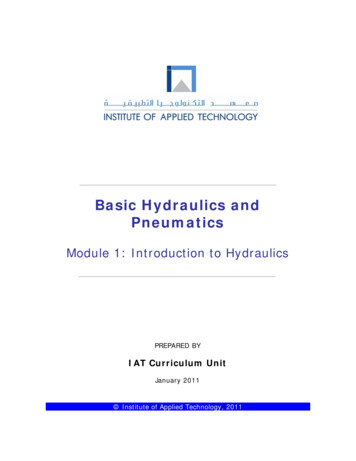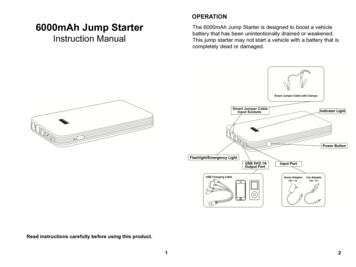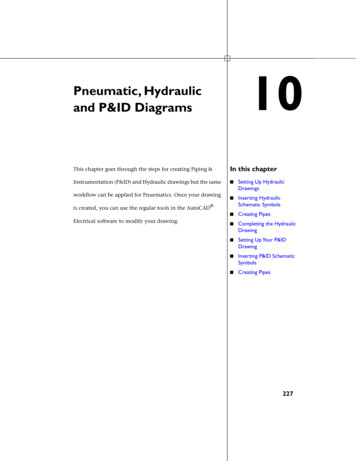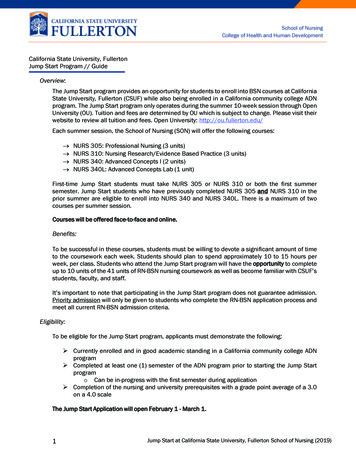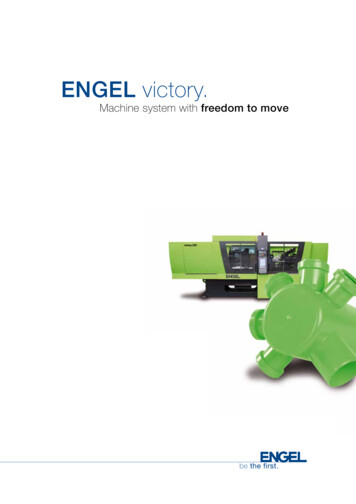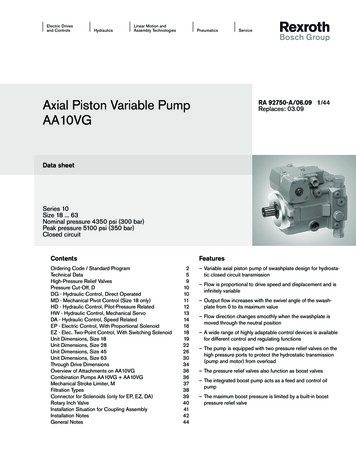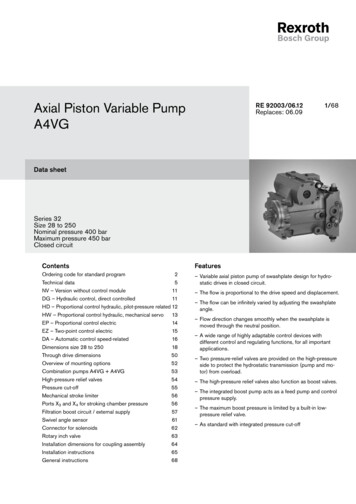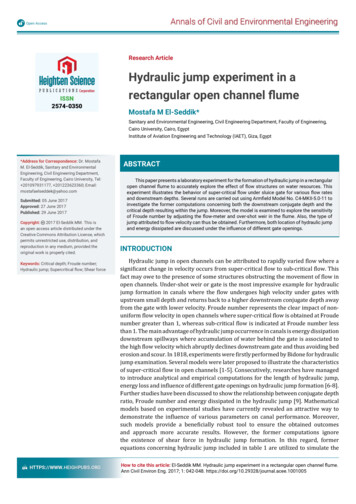
Transcription
Annals of Civil and Environmental EngineeringOpen AccessResearch ArticleISSN2574-0350Hydraulic jump experiment in arectangular open channel flumeMostafa M El-Seddik*Sanitary and Environmental Engineering, Civil Engineering Department, Faculty of Engineering,Cairo University, Cairo, EgyptInstitute of Aviation Engineering and Technology (IAET), Giza, Egypt*Address for Correspondence: Dr. MostafaM. El-Seddik, Sanitary and EnvironmentalEngineering, Civil Engineering Department,Faculty of Engineering, Cairo University, Tel: 201097931177, 201223623360; Email:mostafaelseddek@yahoo.comSubmitted: 05 June 2017Approved: 27 June 2017Published: 29 June 2017Copyright: 2017 El-Seddik MM. This isan open access article distributed under theCreative Commons Attribution License, whichpermits unrestricted use, distribution, andreproduction in any medium, provided theoriginal work is properly cited.Keywords: Critical depth; Froude number;Hydraulic jump; Supercritical flow; Shear forceHTTPS://WWW.HEIGHPUBS.ORGABSTRACTThis paper presents a laboratory experiment for the formation of hydraulic jump in a rectangularopen channel flume to accurately explore the effect of flow structures on water resources. Thisexperiment illustrates the behavior of super-critical flow under sluice gate for various flow ratesand downstream depths. Several runs are carried out using Armfield Model No. C4-MKII-5.0-11 toinvestigate the former computations concerning both the downstream conjugate depth and thecritical depth resulting within the jump. Moreover, the model is examined to explore the sensitivityof Froude number by adjusting the flow-meter and over-shot weir in the flume. Also, the type ofjump attributed to flow velocity can thus be obtained. Furthermore, both location of hydraulic jumpand energy dissipated are discussed under the influence of different gate openings.INTRODUCTIONHydraulic jump in open channels can be attributed to rapidly varied low where asigni icant change in velocity occurs from super-critical low to sub-critical low. Thisfact may owe to the presence of some structures obstructing the movement of low inopen channels. Under-shot weir or gate is the most impressive example for hydraulicjump formation in canals where the low undergoes high velocity under gates withupstream small depth and returns back to a higher downstream conjugate depth awayfrom the gate with lower velocity. Froude number represents the clear impact of nonuniform low velocity in open channels where super-critical low is obtained at Froudenumber greater than 1, whereas sub-critical low is indicated at Froude number lessthan 1. The main advantage of hydraulic jump occurrence in canals is energy dissipationdownstream spillways where accumulation of water behind the gate is associated tothe high low velocity which abruptly declines downstream gate and thus avoiding bederosion and scour. In 1818, experiments were irstly performed by Bidone for hydraulicjump examination. Several models were later proposed to illustrate the characteristicsof super-critical low in open channels [1-5]. Consecutively, researches have managedto introduce analytical and empirical computations for the length of hydraulic jump,energy loss and in luence of different gate openings on hydraulic jump formation [6-8].Further studies have been discussed to show the relationship between conjugate depthratio, Froude number and energy dissipated in the hydraulic jump [9]. Mathematicalmodels based on experimental studies have currently revealed an attractive way todemonstrate the in luence of various parameters on canal performance. Moreover,such models provide a bene icially robust tool to ensure the obtained outcomesand approach more accurate results. However, the former computations ignorethe existence of shear force in hydraulic jump formation. In this regard, formerequations concerning hydraulic jump included in table 1 are utilized to simulate theHow to cite this article: El-Seddik MM. Hydraulic jump experiment in a rectangular open channel flume.Ann Civil Environ Eng. 2017; 1: 042-048. https://doi.org/10.29328/journal.acee.1001005
Hydraulic jump experiment in a rectangular open channel flumelow behavior and compared with the measured outcomes of an experimental lume(Arm ield Model No. C4-MKII-5.0-11). Also, the in luence of low structures on waterlevel variation is studied to reveal shear force existence due to bed roughness [1012]. In this paper, several laboratory experiments are accomplished to explore theupstream conjugate depth for various discharges and downstream water depths byadjusting both low meter and over-shot weir. Also, the type of hydraulic jump can beobserved by simulating Froude number responsible for super-critical low under theimpact of upstream conjugate depth. A novel alternation is developed to express theresponse of hydraulic jump accompanied by critical depth exploration using variouslow structures. Furthermore, the location of jump coupled with energy dissipated isinvestigated by varying the sluice gate openings in the lume.MATERIALS AND METHODSExperimental open channel flumeLaboratory experiments are carried out on a rectangular open channel lume 5m long (Arm ield Model No. C4-MKII-5.0-11) and a basic hydraulic bench (Arm ieldModel No. F1-10-A) as shown in igure1. The open channel width is 10 cm, whereas themaximum water depth can reach about 30 cm. The transparent side walls of channelare made of acrylic glass, whereas the bottom is made of stainless steel. The lume isprovided with a digital low meter for discharge measurement. Also, a point gauge isimplemented for measuring water depth. An over-shot weir is installed at the end ofthe channel to control water depth while a sluice gate is installed in the open channel toform the hydraulic jump. The basic hydraulic bench includes a submersible pump thatsupplies the lume with the required discharge controlled by a valve. The water lowsthrough a connected pipe beneath the lume where low returns back to the hydraulicbench in a closed cycle low. Several experimental runs are performed by varying thedischarge and measuring the corresponding conjugate depths. Accordingly, Froudenumber can be indicated for both sub-critical and super-critical lows. Also, the lengthof jump can be measured by a calibrated scale on the top of channel. Moreover, thelocation of hydraulic jump can be determined by varying the gate openings. The formeranalytical models are simulated and compared with the experimental results in orderto overcome the improper defects in such models and develop a new mathematicalmodel that maintains more accurate outcomes. Table 1 shows the former equationsregarding the relation between conjugate depths and low discharge, energy dissipatedin the hydraulic jump and the in luence of upstream conjugate depth on Froude numberfor different velocities.Figure 1: Open channel Armfield flume Model No. C4-MKII-5.0-11 with a basic hydraulic bench Model No. F1-10-A.Published: June 29, 201743/48
Hydraulic jump experiment in a rectangular open channel flumeTable 1: Former equations for hydraulic jump occurrence in rectangular open channel flumes.DescriptionDownstream conjugate depthFroude number of super-critical flowEquation 1y1 1 8 F12 12vQF1 1, v1 b y1g y1y2 q2Q,q gbCritical depthyc 3Energy dissipated in jump E E1 E2 Momentum and energy principlesSF w A yc w y2 y1 34 y2 y12QQ2, SE y A2 g A2RESULTS AND DISCUSSIONSuper-critical flow and Froude number simulationFroude number is associated with the change of water depth and discharge in openchannels. Figure 2 shows the simulation results of downstream conjugate depth (Y2)by varying upstream conjugate depth (Y1) and lowing discharge (Q) in the conjugatedepth equation mentioned in table 1. Figure 2a, illustrates that the upstream conjugatedepth decreases as the downstream conjugate depth increases at constant discharge,whereas an increment in the downstream depth is obtained as discharge increases atconstant upstream depth. Figure 2a also indicates that Y2 reaches about 0.1m at Y1of 0.01m and speci ic discharge (q) of 0.01m3/sec/m. Accordingly, igure 2b indicatesthat the Froude number at the upstream depth boosts as upstream depth declines thatcan be attributed to the increase in low velocity. On the other hand, an enhancementin the upstream Froude number is achieved by increasing the low discharge atconstant upstream depth as shown in igure 2b. Moreover, a signi icant increase inFroude number is recognized as a result of a minor decrement in the upstream depthcompared to the change in low discharge that can lead to bed scouring.EXPERIMENTAL RESULTSSpecific force at gate vena-contractionSeveral experimental runs were carried out in the laboratory to reveal the impact ofthe sluice gate on the location and type of hydraulic jump (Table 2). The experimentalresults demonstrate that the hydraulic jump approaches the sluice gate as the gateopening increases till the gate becomes submerged. The reason behind this fact mayowe to the decline in the velocity under gate as it is raised and accordingly the speci icforce at the jump overcomes that of the gate vena-contraction. However, the formationof eddy currents in the hydraulic jump is relevant to the constant reverse slope [13].Also, the obtained results indicate that the type of the hydraulic jump is associatedwith both the installed gates and the discharge. Regarding supercritical low, Froudenumber (F1) increases from 1.1 to 1.5 at run 1,2 respectively as Q increases from 20to 30 l/min for constant Y2 and gate opening (d). On the other hand, F1 can be boostedfrom 1.4 to 2.6 by increasing Y2 from 5cm to 6cm for constant discharge and gateopening as shown in run 7,8, respectively. Compared with the measured results, thesimulated Y2 reveals a higher value of about 10 cm at Y1 of 0.01 m and Q of 50 l/min. Thus, former computations should be enhanced with shear force existence to obtainmore accurate results. However, the minor change between simulated and measuredresults may owe to the small dimensions of lume and low discharge. It is also evidentfrom results that both the location of hydraulic jump and water depth behind the gate(H) are attributed to the gate opening coupled with discharge at constant conjugatedepths. However, Y2 may affect hydraulic jump position as shown in run 5,6,7,8,included in Table 2. Moreover, the length of jump increases and Y1 decreases byincreasing Y2 as indicated in run 5,6,7,8, included in Table 2. Furthermore, the changein upstream and downstream depth leads to a change in the energy of an average 0.06m [14,7].Published: June 29, 201744/48
Hydraulic jump experiment in a rectangular open channel flume(b)(a)Figure 2: Upstream conjugate depth versus (a) downstream conjugate depth for various discharges per unit widthof flume and (b) Froude number at different super-critical flows.Table 2: Experimental runs for the location and type of hydraulic jump at various gate openings (d) and discharges (Q).Rund (m)1Q (l/min)20Y1 (m)0.01@ 4.05m300.01@ 3.70m0.005@ 4.19m2340.007@ 4.19m5672030300.01@ 3.00m8405050ND*0.01@ 3.65mND*0.013@ 2.50m0.015@ 2.35m0.01@ 3.00mY2 (m)H (m)F1F20.03@ 4.00m0.141.10.20.03@ 3.65m0.191.50.30.030.03@ 3.70m0.030.045@ 2.37m0.05@ 2.25m0.06@ 2.75m0.090.170.12submerged gate1.50.3submerged gate0.221.40.20.211.40.20.212.60.2*ND: Non – Dectectable.Validation of the hydraulic jump modelThe experimental work was accomplished in the laboratory to explore the criticaldepth and the conjugate depths of hydraulic jump as shown in igures 3,4. Two slots 2.5cm and 1 cm are installed as overshot weir at the end of the lume to control Y2. Figure3a,c shows that the measured Y1 and Y2 reach 2 cm and 6 cm, respectively at 2 cm gateopening and measured low rate of about 67.3 l/min as shown in igure 3b. However,the critical depth can theoretically be indicated as 2.3 cm. Accordingly, the jump occursjust downstream sluice gate with Y1 of about 2.3 cm in such case. On the other hand,a broad crested weir is used instead of the gate to determine the characteristics ofhydraulic jump as shown in igure 3d. Consecutively, another experimental run isperformed to verify the critical depth as illustrated in Figure 4. The gate opening isreduced to 1.5 cm and the low rate is adjusted at 53.5 l/min as indicated in igure 4a,b,respectively. The depth of water behind gate increases to 22 cm as the gate is loweredstep by step in order to form the jump just after gate. The measured critical depth canbe assessed as 2 cm that agrees with the theoretical calculation, whereas Y1 and Y2approach 1.5 cm and 5.5 cm, respectively. Also, same results can be obtained for thehydraulic jump using a crump weir where the difference in upstream levels of jump isabout 1.5 cm at Q of 53.5 l/min as shown in igure 4c,d. Nevertheless, two slots 1 cmand 1 cm are utilized to control Y2 of about 4 cm In brief, Y2 varies from 5.5 cm to 4cm by replacing sluice gate with crump weir although Y1 and Q maintain at 1.5 cm and53.5 l/min, respectively. The reason behind this fact may owe to the change in shearstress for the jump formed by the gate and the weir [15,16].Published: June 29, 201745/48
Hydraulic jump experiment in a rectangular open channel flume(a)(b)(c)(d)Figure 3: (a) Measured upstream conjugate depth of hydraulic jump, (b) Measured discharge through digital flowmeter, (c) Measured downstream conjugate depth of hydraulic jump and (d) different locations of hydraulic jump.(a)(c)(b)(d)Figure 4: (a) Measured critical depth of the hydraulic jump, (b) Measured discharge through digital flow meter, and(c) Measured weir level and (d) Measured water level at upstream conjugate depth of hydraulic jump.Published: June 29, 201746/48
Hydraulic jump experiment in a rectangular open channel flumeCONCLUSIONSA hydraulic jump experiment was accomplished in a rectangular open channellume under the in luence of various low structures. Several experimental runs wereaccomplished to obtain Y2 by measuring Y1 and Q using different low structures andvarious gate openings. The measured values of Y2 disagree with the simulated resultsof former equations. Also, the measured Y2 varies by varying the low structure forthe same Y1 and Q that reveals that the former equations of hydraulic jump shouldbe modi ied to show the impact of shear force due to friction between hydraulic jumpand bed of water canals. The change in downstream depth is relevant to the existenceof shear force resistance obtained by the low structure in water canals that can leadto bed scouring. Regarding open channel lume, the impact of shear force may oweto the friction between hydraulic jump low and wall sides. Also, the experimentalruns revealed that upstream Froude number increases from 1.4 to 2.6 by increasingdownstream depth from 5 cm to 6 cm at constant discharge and gate opening where thejump returns back to the gate owing to the decline in speci ic force vena contraction.ACKNOWLEDGEMENTSThe author acknowledges the assistance provided by Institute of AviationEngineering and Technology in supplying Hydraulic laboratory with Arm ield openchannel lume imported from England in 2015.REFERENCE1. Lau YL, Liu D. Effect of flow rate on biofilm accumulation in open channels. Water Research. 1993;27: 355-360. Ref.: https://goo.gl/g66Gxj2. Sofialidis D, Prinos P. Turbulent flow in open channels with smooth and rough flood plains. JHydraulic Res. 1999; 37: 615-640. Ref.: https://goo.gl/sJuWW53. Chanson H. Minimum Specific Energy and Critical Flow Conditions in Open Channels. J IrrigationDrainage Eng. 2006; 132: 498-502.4. Bilgil A, Altun H. Investigation of flow resistance in smooth open channels using artificial neuralnetworks. Flow Measurement and Instrumentation. 2008; 19: 404-408. Ref.: https://goo.gl/V2XZ5T5. Song CG, Seo IW, Kim YD. Analysis of secondary current effect in the modeling of shallow flow inopen channels. Advances in Water Resources. 2012; 41: 29-48. Ref.: https://goo.gl/2d998M6. Hussain A, Ahmad Z, Ojha CSP. Analysis of flow through lateral rectangular orifices in open channels.Flow Measurement and Instrumentation. 2014; 36: 32-35. Ref.: https://goo.gl/KjpNi57. Kim Y, Gyewoon Choi G, Park H, Byeon S. Hydraulic Jump and Energy Dissipation with Sluice Gate.Water. 2015; 7: 5115-5135. Ref.: https://goo.gl/QeMC6o8. Shamloo H, Pirzadeh B. Analysis of roughness density and flow submergence effects on turbulenceflow characteristics in open channels using a large eddy simulation. Applied Mathematical Modelling.2015; 39: 1074-1086. Ref.: https://goo.gl/jq2b5a9. Gandhi BK, Verma HK, Abraham B. Mathematical modeling and simulation of flow velocityprofile for rectangular open channels. ISH Journal of Hydraulic Engineering. 2016; 22: 1-11. Ref.:https://goo.gl/4hRSg610. Sadeque MA, Rajaratnam N, Loewen MR. Effects of Bed Roughness on Flow around Bed-MountedCylinders in Open Channels. Journal of Engineering Mechanics. 2009; 135: 100-110. Ref.:https://goo.gl/uFg4o711. Burger J, Haldenwang R, Alderman N. Friction factor-Reynolds number relationship for laminar flowof non-Newtonian fluids in open channels of different cross-sectional shapes. Chemical EngineeringScience. 2010; 65: 3549-3556. Ref.: https://goo.gl/BxYL7T12. Blanckaert K, Duarte A, Schleiss AJ. Influence of shallowness, bank inclination and bank roughnesson the variability of flow patterns and boundary shear stress due to secondary currents in straightopen-channels. Advances in Water Resources. 2010; 33: 1062-1074. Ref.: https://goo.gl/Lt9Vae13. D’Oria M, Tanda MG. Reverse flow routing in open channels: A Bayesian Geostatistical Approach.Journal of Hydrology. 2012; 460-461: 130-135. Ref.: https://goo.gl/qjERvGPublished: June 29, 201747/48
Hydraulic jump experiment in a rectangular open channel flume14. Kim YJ. Energy Dissipation Effect of the Downstream at Under Flow Movable Weir. Ph.D. Thesis,Incheon National University, Incheon, Korea. 2013.15. Ba Tuyen N, Cheng N. Flow Resistance in Smooth Rectangular Open Channels with Low AspectRatios. Journal of Hydraulic Engineering 2012; 138: 817-821. Ref.: https://goo.gl/PT72pR16. Abbaspour A, Parvini S, Dalir HA. Effect of buried plates on scour profiles downstream of hydraulicjump in open channels with horizontal and reverse bed slopes. Water Science and Engineering. 2016;9: 329-335. Ref.: https://goo.gl/9p9FnmPublished: June 29, 201748/48
Hydraulic jump experiment in a rectangular open channel fl ume Published: June 29, 2017 45/48 Validation of the hydraulic jump model The experimental work was accomplished in the laboratory to
